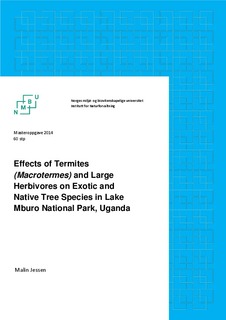| dc.description.abstract | Both termites and large herbivores are important to ecological processes in the African savannah. Termites and large herbivores contribute to spatial heterogeneity in distinct ways. Large herbivores facilitate tree regeneration through feeding preferences, thereby causing reduced competition between grasses and woody plants. Herbivores also act as predators on tree seedlings, thus reducing seedling growth and survival. Termites of the genus Macrotermes are considered pests in plantation sites, although they also act as ecosystem engineers through their rearrangements of soil layers and nutrient-rich termite mounds (termitaria). This study focused on the effects of termites and large ungulates on growth and survival of both native and exotic seedlings in Lake Mburo National Park, Uganda. A total of 720 seedlings representing four different species were planted and measured in open and fenced plots, controlling the access of large herbivores. Within each plot, five individuals of each species were either covered with a netted basket or uncovered, thus unprotected from termite attacks. Treatments were replicated at nine different sites throughout the park. Termites were observed in situ biting off seedling stems, as well as by holes and disturbances on the top soil layer. Herbivore activity was observed within sites in the form of dung, clay and scrape markings on the ground. Exclusion of large herbivores had a positive effect on seeding growth rate and seedling survival. All four species had highest growth rates when protected from both herbivores and termites, and Eucalyptus grandis grew taller than any of the other tree species. The exotic seedlings had higher survival rates compared to the indigenous seedlings. Termites had an additional small negative effect on seedling growth when combined with herbivore browsing. Termites also negatively affected native seedlings by reducing survival to 20% in plots where both large herbivores and termites accessed the seedlings. Termites had little impact on the survival of exotic species. Based on these results, I suggest that predation of large herbivores and termites on seedlings have a negative effect on tree regeneration in Lake Mburo National Park. The negative effect of termites on indigenous seedlings is probably a result of joint effects of termite preferences and herbivore activity, as termite impact on seedlings are only seen when combined with the influence of large herbivores. | nb_NO |
